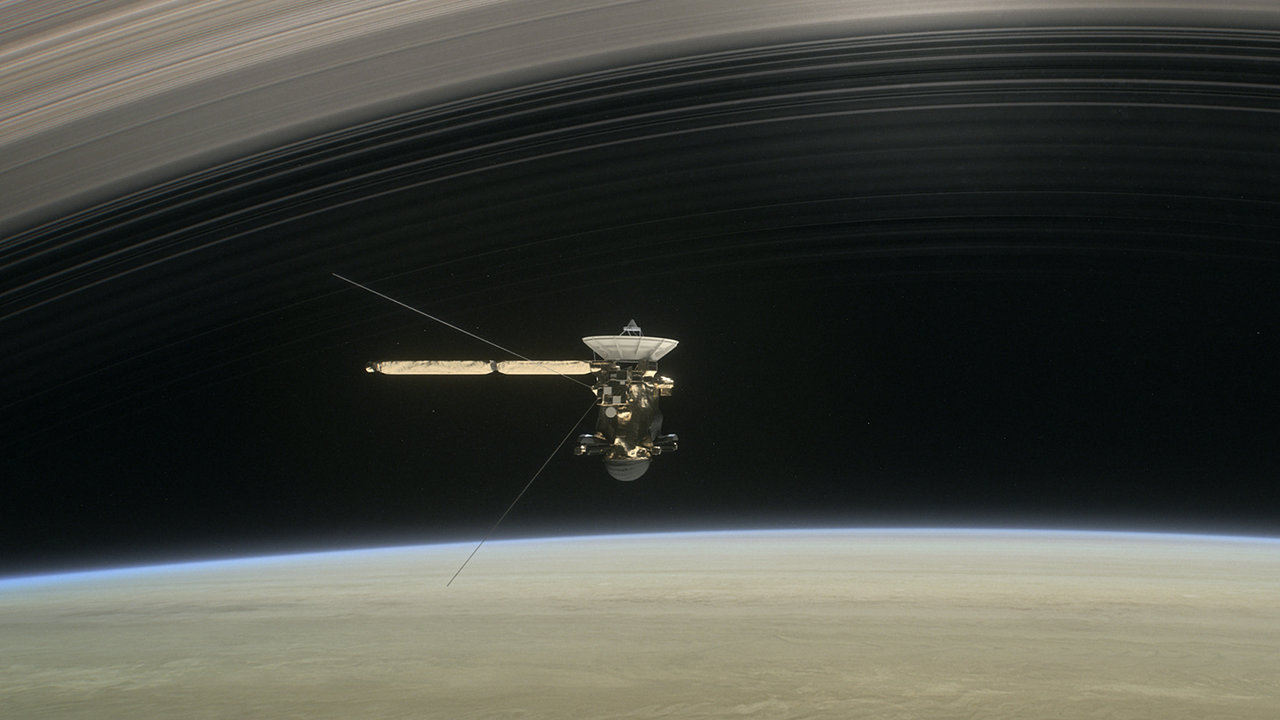This still shows the spacecraft diving between Saturn and the planet's innermost ring.
Mission Summaries and Context Information
For finding and analyzing Cassini data there are many commonly used resources, information,
and tools available on this page. Resources include items such as the Tour Atlas, various
Crossings and Hazards, and other information applicable to the entire mission. In addition, the software
tools available include search and geometry calculation tools that are used across multiple disciplines.
The
Cassini Tour Atlas The Cassini Tour Atlas Readme.pdf link provides geometry tables for the mission.
See the
Master Schedule for a time-ordered listing of observations by all instruments.
Search Tools
Cross-instrument Search
- Event Calendar can help cross-reference events
with dates so that finding data in the PDS is easier.
Geometry and Trajectory Visualization
- Digit is a web-based graphics and information tool for Cassini geometry and trajectory visualization.
Optical Remote Sensing instruments
- PDS Imaging Atlas is a search tool for remote imaging data, including ISS (optical camera), RADAR, and VIMS (visible and infrared spectrometer).
It helps search by a variety of parameters including target, light geometry, time ranges, and much more.
- OPUS is a search tool for remote imaging data on the PDS Rings Node. It includes ISS (optical camera), CIRS (infrared spectrometer), UVIS (ultraviolet spectrograph) and VIMS (visible and infrared spectrometer).
It helps search by a variety of parameters including target, light geometry, time ranges, and much more.
Searching for Data Related to Surfaces of Moons
- Titan Trek is a map-based tool to search for data on Titan that evaluates search results in the context of geographical maps.
- Icy Trek is a map-based tool to search for data on several other icy moons of Saturn that evaluates search results in the context of geographical maps.
- PILOT is a map-based search tool to help find images of Saturn and its moons.
Searching for Data by Geometry
- SPICE WebGeocalc provides a web-based graphical user interface to many of the observation geometry computations available from the SPICE system. Users can perform SPICE computations without the need to write a program; the user need have only a computer with a standard web browser. The WebGeocalc Tutorial provides an introduction to this tool.
- Users searching for CAPS, CDA, and INMS data using SPICE should be aware that there will be additional information shown regarding the pointing of the instrument relative to the spacecraft.
- NAIF/SPICE Software is for SPICE calculations that cannot be done in WebGeocalc, since users can program their own calculations in SPICE.
- An Explanation of Cassini C-Kernels
Fields and Particles instruments
- Autoplot is a data visualization application that is useful for fields & particles data.
Reference Tables to Help Find Data
The tables below cross-reference time and date stamps to events important to the analysis of field and particle data.
Orbit Plots and Time Tables
- The Cassini Tour Atlas includes time reference tables across the mission that reference various orbit conditions, flybys of satellites and rings, and occultations of rings and satellites.
- Orbital inclination plots across the entire Cassini Tour - or split up with additional annotations by Primary, Equinox and Solstice Missions
- Periods when Cassini is within 10 Rs (CSV) and 15 Rs (CSV)
- Apoapses (revolution, epoch, period, orbital inclination, range) (CSV)
- Periapses (revolution, epoch, latitude, phase, period, range) (CSV)
- Ring Plane Crossing (revolution, ascending, or descending epoch, range) (CSV)
- Dust Crossings (revolution, target, epoch) (CSV)
- Dust Hazards (revolution, event, epoch) (CSV)
- Conjunctions (revolution, time) (CSV)
- The Master Schedule contains time references to a variety of mission events.
Magnetosphere Crossing Time Tables
 PDS: The Planetary Atmospheres Node
PDS: The Planetary Atmospheres Node
